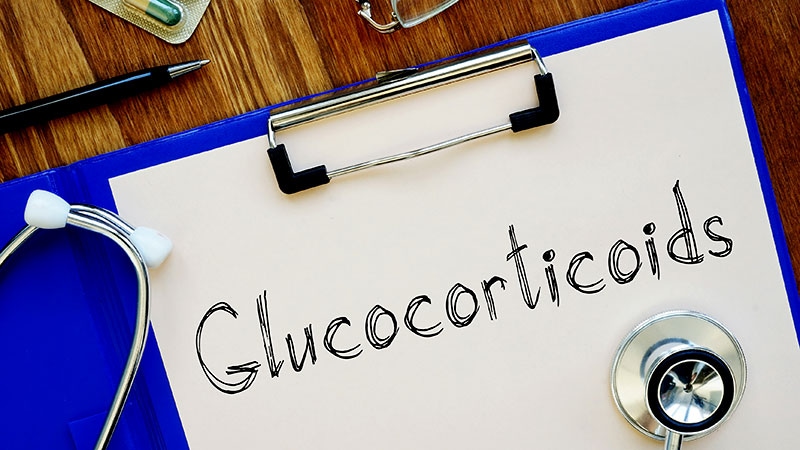NEW ORLEANS — Children and adults with congenital adrenal hyperplasia (CAH) often receive supraphysiologic doses of glucocorticoids, resulting in adverse effects while at the same time not achieving adequate androgen suppression.
In CAH, a genetic mutation causes deficiency in an enzyme, most often 21-hydroxylase, leading to impaired cortisol synthesis and excess androgen production.
Glucocorticoid replacement is the only treatment currently available. This is often given in supraphysiologic doses to not only correct the deficiency but also lower the levels of adrenocorticotropic hormone (ACTH) and adrenal androgen production. However, glucocorticoid treatment at supraphysiologic doses has been linked to numerous complications, including weight gain, diabetes, cardiovascular disease, and osteoporosis.
New data from Neurocrine Biosciences presented at the American Association of Clinical Endocrinology (AACE) Annual Meeting 2024 document the limitations of current CAH treatment, setting the stage for upcoming new phase 3 adult and pediatric data on crinecerfont, an oral, selective corticotropin-releasing factor type 1 receptor antagonist under investigation for the treatment of CAH due to 21-hydroxylase deficiency.
Session Moderator Anupam Kotwal, MD, assistant professor in the Division of Diabetes, Endocrinology and Metabolism, at the University of Nebraska Medical Center, Omaha, Nebraska, told Medscape Medical News, “We struggle a lot with trying to get patients better controlled from their androgen standpoint in CAH but then not give them all the side effects from too much glucocorticoid.”
In some instances, he said, patients are given high glucocorticoid doses to suppress androgens for fertility, then the doses are never readjusted. Or patients “may change care so CAH is diagnosed in childhood or adolescence, then they transition to adulthood in their 20s where they’re just taking higher doses and may not have good endocrine follow-up.”
On May 10, 2024, at the AACE meeting, Oksana Hamidi, DO, an endocrinologist in the Department of Internal Medicine at The University of Texas Southwestern Medical Center, Dallas, presented baseline data for 182 CAHtalyst participants. They had a mean glucocorticoid dose of 17.6 mg/m2/d and elevated mean androstenedione of about three times the upper limit of normal, “indicating inadequate androgen control despite supraphysiologic glucocorticoid dosing.”
Consequently, “Participants experienced a spectrum of disease-related and treatment-related comorbidities. Participants showed clinical evidence of GC, ACTH, and androgen excess, including high prevalence of obesity, hirsutism in females, and testicular adrenal rest tumors in males,” Hamadi said.
A poster also presented on May 10, 2023, at AACE showed data from available medical records for 33 adult and 43 pediatric patients in the Congenital Adrenal Hyperplasia: Patient and Clinical Outcomes in Real-World Practice Settings registry. Hydrocortisone was the most common glucocorticoid prescribed in both children and adults with CAH, with an average daily dose at the upper end or above those of the ranges recommended by the Endocrine Society in 2018.
“Treatment regimens for patients with CAH are characterized by complexity with frequent changes throughout their life, emphasizing the need for comprehensive management,” pediatric endocrinologist Oksana Lekarev, DO, of Weill Cornell Medical Center, New York City, and colleagues said in their poster.
In September 2023, Neurocrine Biosciences released positive top-line data from the randomized, double-blind, placebo-controlled Phase 3 CAHtalyst Adult Study, and in October 2023, they announced top-line results from the Phase 3 CAHtalyst Pediatric Study of crinecerfont.
Both trials met their primary endpoints. In adults, crinecerfont resulted in a significant percent reduction in daily glucocorticoid dose vs placebo, while maintaining androgen control at week 24 (P < .0001 vs placebo). In the pediatric study, the drug resulted in a significant decrease in serum androstenedione from baseline at week 4 vs placebo following a glucocorticoid stable period (P = .0002).
Regarding crinecerfont, Kotwal said, “It seems promising…I personally think it would be a pretty big deal because they’re trying to address the issue from the ACTH standpoint. Right now, all the medicines we have just suppress the adrenal production, but once we can get something upstream, to reduce the over-secretion of these androgens without causing as much side effect from too much steroids, I think that would be close to a game-changer.”
Full data from the Phase 3 CAHtalyst Adult Study are scheduled to be presented on June 1, 2024, at the Endocrine Society meeting in Boston.
All the studies were funded by Neurocrine Biosciences, Inc. Hamidi has been a principal investigator on clinical trials in CAH with Neurocrine Biosciences, Inc. She also reported advisory board participation with Corcept Therapeutics, Recordati Rare Diseases, Amryt Pharma, Xeris, Lantheus, and Neurocrine Biosciences. Kotwal had no disclosures.
Miriam E. Tucker is a freelance journalist based in the Washington, DC, area. She is a regular contributor to Medscape Medical News, with other work appearing in the Washington Post, NPR’s Shots blog, and Diatribe. She is on X: @MiriamETucker.
